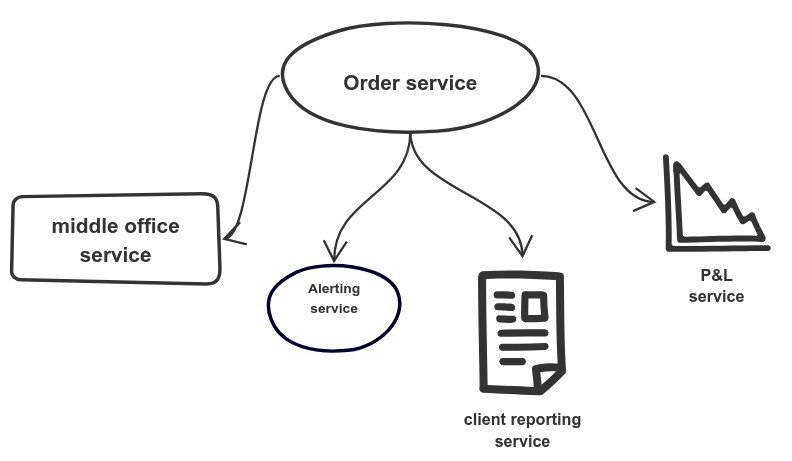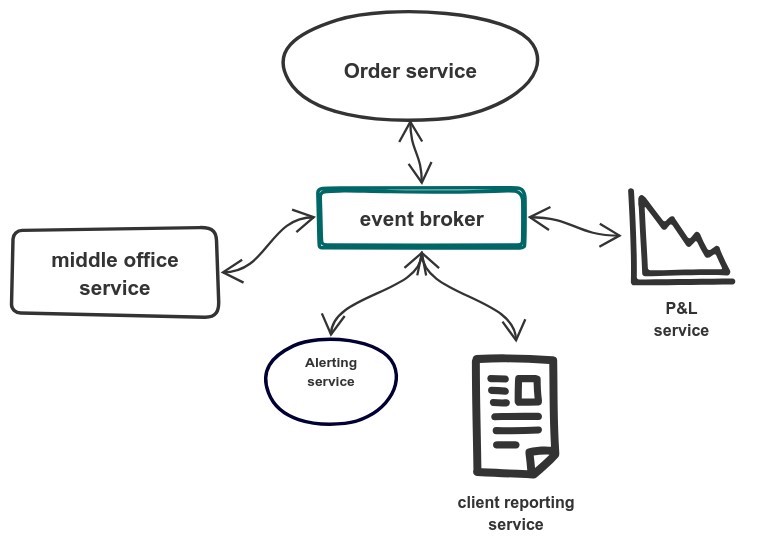You can now subscribe to get notified of my latest posts!
In one of my previous posts, I discussed the evolution of application architecture from monolithic to service-oriented to microservices and eventually, to event-driven. I concluded that post with a brief introduction to event-driven architecture (EDA) and promised to dive deeper into the topic in a future post. Well, here we are. In this post, I would like to talk about a type of architecture that you have undoubtedly heard about numerous times in the last few years. Despite having existed for several years, it has suddenly become extremely popular and a necessity for all the companies seeking digital transformation.
However, EDA is nothing new. Anyone who has worked at a financial services company (i.e. investment banks) knows applications have been using EDA for many many years. In fact, if you work at a financial services company, you probably think of EDA as the latest buzzword just like ‘big data‘ a few years ago. But if you were to talk to anyone working in a different industry, such as pharmaceuticals or retail, you would get a very different reaction.
The truth is that most of the world is just realizing the importance of event-driven architecture and the need to be real-time.
The importance of being real-time
I really like Delta Airlines. It has a good loyalty program, comfortable seats, good coverage (domestic and international) and a fantastic app.

Any time there is an important event, I am notified in real-time. Flight is delayed? Notified! Boarding pass is ready? Notified! Baggage checked-in? Notified! My all-time favorite is getting a notification letting me know the carousel number where my luggage will arrive!
This is the power and beauty of being real-time. Legacy applications are batch-based whereas modern applications are real-time.
With the rise of smartphones, consumers demand every application to be real-time. These applications must have all the necessary information in real-time and must be able to push events to consumers instead of consumers asking for updates. For example, only a few years ago, banks would send you monthly credit card statements. If there was a fraudulent transaction, you would have a terrible time trying to convince the bank that $300 bar tab from 25 days ago was not yours. But nowadays, almost every bank, provides you with a real-time credit card statement.
From the bank’s perspective, being real-time allows them to be more reactive to fighting fraud. They are able to now analyze their data in real-time and identify fraudulent activity much sooner than before.
Being event-driven allows corporations to serve their customers better and to be better prepared for any issues. In today’s world, there are very few consumer-oriented corporations that haven’t already transitioned or are thinking of transitioning to using event-driven architecture and becoming real-time.
What are events?
Before we dive further into details, let’s clarify what an event really is.
An event is, simply, an occurrence or change in the state of a system.
This could be an order placed by a customer on an e-commerce site or a change in CPU utilization of a system. Events can be generated by internal or external sources such as a mouse, a keyboard, a thermostat and/or a sensor on your refrigerator.
It’s important to note the difference between events and event notifications. An event notification is simply a message about the occurrence of an event.
What is event-driven architecture?
Now that we know what an event is, how can we define event-driven architecture? EDA is a type of architecture where events are at the center of the system design.
Such a system is critically focused on:
- communicating,
- capturing,
- processing, and
- persisting/replaying events
In an EDA, you have producers and consumers where producers publish events and consumers are responsible for capturing and processing events.
You can have an application or a service that can be both a producer and a consumer.
Benefits of event-driven architecture
There are numerous advantages of using EDA.
Loosely-coupled
EDA allows your applications to be loosely-coupled since your producers have the luxury of publishing events without worrying about how they will be consumed and processed. This means your publishers can be written in Java whereas your consumers might be written in python and c++.
Scaling
Event-driven architecture allows your system to be easily scalable. When you don’t have services directly communicating with each other, you don’t have to worry about writing and managing multiple APIs. This reduces unnecessary complexity and allows your system to scale.
Asynchronous messaging
A critical component of EDA is asynchronous messaging provided by event brokers. Event brokers provide several features such as advanced topic routing, persistence, guaranteed ordering, zero message loss and replay that are at the core of what EDA enables you to achieve.
For example, imagine we have a trade order management system (OMS) where whenever an order is placed, you have to notify the client, report the transaction to middle-office, inform compliance and finally, notify the P&L team.

In a non-EDA system, you might use synchronous RESTful APIs to communicate between these different services. They are simple and easy to use, but, at the end of the day, they make synchronous calls which means, as your order service makes all of those API calls, it has to wait for each request to finish before it can proceed. This is unacceptable because you can’t have your order service depend on other services such as P&L service. Imagine not being able to send new orders because your P&L service was down!
However, in an asynchronous world, life is much simpler. As soon as an order is placed, an order event is published by your order service to the appropriate topic (i.e. /NA/US/clientId/portfolio/order). Any downstream service which is interested in order events will subscribe to the order topic and consume related events without blocking the original order service.

This allows your order service to continue sending new orders and not have to worry about downstream services.
Smart routing
Event brokers, such as Solace’s PubSub+, allow you to send and route asynchronous events using rich hierarchical topics. You can consume events using the exact topic or wildcards which allow your services to be extremely flexible. For example, a service can subscribe to all the orders in US by subscribing to */US/> or subscribe to all the events (not just orders) corresponding to a specific portfolio by subscribing to */*/*/portfolio/>.
Persistence and replay
Additionally, event brokers allow events to be persisted via queues which means if all your downstream services are not online, the events will not be lost forever. As the services will come back online, they will be able to process the events.
Modern event brokers, such as Solace’s PubSub+, are also capable of replay so that if you have a brand new analytics service interested in old events, it can simply replay older events.
Some challenges with event-driven architecture
There are always some pros and cons to each type of architecture. While EDA can sound tempting, one should carefully evaluate whether their application requires it. You don’t want to over-engineer your small application which only manages a handful of events.
You should also make sure to choose the most appropriate event broker with features that are important to your use-case. If replay is important to you then don’t pick an event broker which does not support it!
When designing event-driven architecture, it is crucial to spend a good amount of time thinking about topics and queues. You should use rich descriptive hierarchical topics that will be useful down the road.
Finally, events can get out of control easily. You might start with 100 events but soon, as your application grows, they might turn to 10,000 and then quickly 1 million events. How do you map the flow of events in your system? Which events are published by which publishers and which events are consumed by which consumers? And, what’s the schema for each event? If you are familiar with this problem and are looking for a solution, I recommend taking a look at Solace’s PubSub+ Event Portal which is a single place to design, create, discover, share, secure and manage all events within your system.
That’s it for this post. I hope this post provided you with a better understanding of event-driven architecture and why you should think about implementing it in your system!